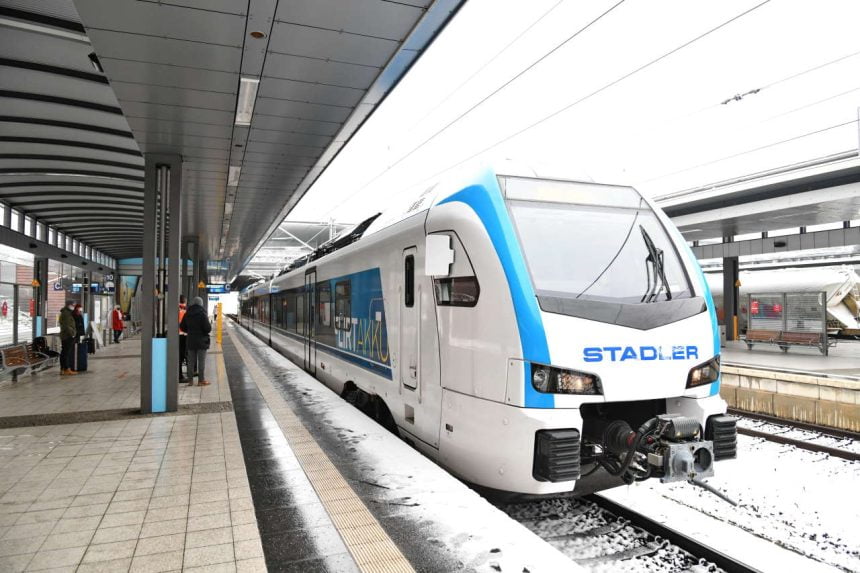Stadler has set a World record for the distance travelled by a battery train in battery-only mode.
Stadler has applied for the record to be officially entered in the Guinness Book of World Records for the distance travelled by a battery train in battery-only mode.
A three-car FLIRT Akku unit travelled on the route from Berlin to Warnemünde in the presence of independent technical consultants and reached a distance of exactly 224 km. in wintry conditions with the temperature around freezing point.
The FLIRT Akku is a battery-electric multiple unit (BEMU) that will run as both a classic EMU (electric multiple unit) under overhead lines or battery-operated on non-electrified routes.
In 2019, Stadler supplied 55 FLIRT Akkus to the Schleswig-Holstein Local Transport Association, NAH.SH, and in November 2021 Deutsche Bahn Regio ordered 44 of the vehicles. Stadler is also building the first hydrogen-powered FLIRT for the San Bernardino County Transportation Authority in the USA.
Since 2016 Stadler has been developing the three-car FLIRT Akku used for the record journey low carbon-neutral solution for operation on non-electrified railway lines. The train was launched in 2018, since when it has travelled around 15,000 km. in battery-only mode, before setting the world record.
Evelyn Thiel, Technical Project Leader for the FLIRT Akku at Stadler, said “We designed and calculated the vehicle for an operational range of 80 kilometres, depending on the route requirements of the respective network. But on various journeys testing the technology, we were able to realize significantly greater ranges, so that we even dared to attempt the world record at wintry temperatures. The vehicle had already had to cope with various scenarios like making up for unplanned delays on the track or operating under extremely hot or cold weather conditions in the testing after all”.
Dr. Ansgar Brockmeyer, Executive Vice President Marketing & Sales and Deputy CEO of Stadler, said “We are very proud to be the official holder of the world record for travelling the longest route in battery-only mode with a regional train now – having reached this result under weather conditions which are anything but ideal for batteries. Stadler has already worked in the area of battery technology for rail vehicles over 75 years ago. We consistently continued to pursue this approach for unusual technological solutions in the company, and developed a flexibly deployable train that also enables CO2-neutral mobility on so-called diesel routes with the FLIRT Akku. As a market and technology leader in battery technologies for rail vehicles, the decision to undertake the record journey was a logical consequence.”
Heiko Hüserich, TÜV Nord, added “We can confirm that the FLIRT Akku test carrier travelled exactly 224.00 kilometres in battery-only mode on the journey from Berlin-Gesundbrunnen to Warnemünde without charging its batteries from an overhead contact line or other external energy source.”
The first FLIRT “Fast Light Intercity and Regional Train” was developed in 2002 at the request of the Swiss Federal Railways SBB for the Zug city railway, and went into passenger use as a four-car unit under the name of RABe?523 2004. Since then, FLIRTs have become international bestsellers with over 2,000 vehicles sold. Vehicles of this type are being operated in 20 countries in virtually all climate zones, from the equator to the polar circle, with 528 of them in Germany alone.
The single-decker regional and intercity multiple units provides flexibility in operation and can be configured as two to six-car units in various gauges. They have a top speed of 160 to 200 km/h and can be powered by electric, diesel or bi-mode drives, as well as battery and hydrogen propulsion.

Using brand new batteries I would imagine. Would like to see this performance demonstrated after 12 months of (ab)use – charging / discharging / vibration / baked in the summer sun etc.
Trains use LFP batteries, that doesn’t happen.
Would like to see how the fuel consumption of a petrol / diesel car stacks up on short winter drives versus claimed performance!